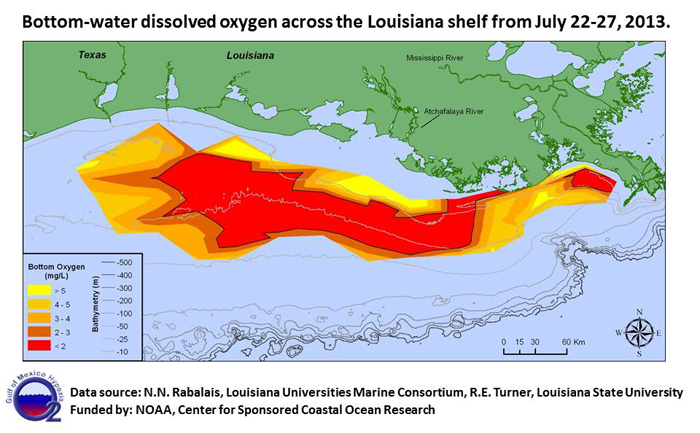
(St. Louis) – A larger than average “Dead Zone” in the Gulf of Mexico is our summer reminder that nitrogen and phosphorus pollution remains one of our nation’s greatest water quality challenges.
See the map (also above): http://www.gulfhypoxia.net/Research/Shelfwide%20Cruises/2013/DOMaps/
The Gulf of Mexico Dead Zone is an area where oxygen levels in the water are too low to support marine life. This year it measures more than 5,800 square miles.
Nitrogen and phosphorus pollution fuel the excessive growth of algae which dies and decomposes, sucking the oxygen from the water. Ocean animals flee the Dead Zone – or die if they cannot escape it. Nitrogen and phosphorus pollution has many sources, including farm fertilizers, wastewater treatment plants and some industries. The Mississippi River delivers the pollution to the Gulf. The largest contributor to the Gulf Dead Zone pollution is agriculture.
Missouri has ranked among the top five states for contributing these Dead Zone pollutants to the Gulf.
“Missouri farmers have no interest in destroying Gulf fisheries, at least not on purpose,” said Kathleen Logan Smith, Policy Director for the Missouri Coalition for the Environment. “However, we still have farmers whose decisions are solely based on profit and yield with little respect for soil and water quality. Because good farm stewardship can deliver profitable crops, fertile soil into the future and clean water today, it’s time all our farmers commit to doing what works.”
The best strategy for reducing Missouri’s contribution to Dead Zone pollutants is improved farm management to keep fertilizers on fields where crops can use them. However, high corn and soybean prices often lure farmers to gain a few more acres by eliminating their field and stream buffer strips that can intercept these pollutants. Tying good conservation practices to crop insurance subsidies would help restore the balance toward good stewardship. In the Farm Bill, the measures that address this problem are known as “Conservation Compliance” and the “National Sod Saver” provision. Both measures ensure that taxpayers do not subsidize pollution and soil erosion.
In addition, annual soil tests, corn stalk nitrogen testing, and ensuring crops have proper and complete micronutrients can help farmers avoid over-applying fertilizer. Winter cover crops can help improve the ability of soils to hold fertilizers and moisture for crop use, preventing pollution from being washed into streams while aiding drought resistance. For tile-drained fields, drainage management systems can stop the flow of fertilizer-rich water into the rivers that reach the Gulf.
“Smarter farming can shrink the Dead Zone,” said Logan Smith. “The question now is one of commitment.”
The Missouri Coalition for the Environment founded 1969, is a non-profit, non-partisan, 501(c)(3) state-level conservation organization and the state’s leading environmental voice in water quality policy.
